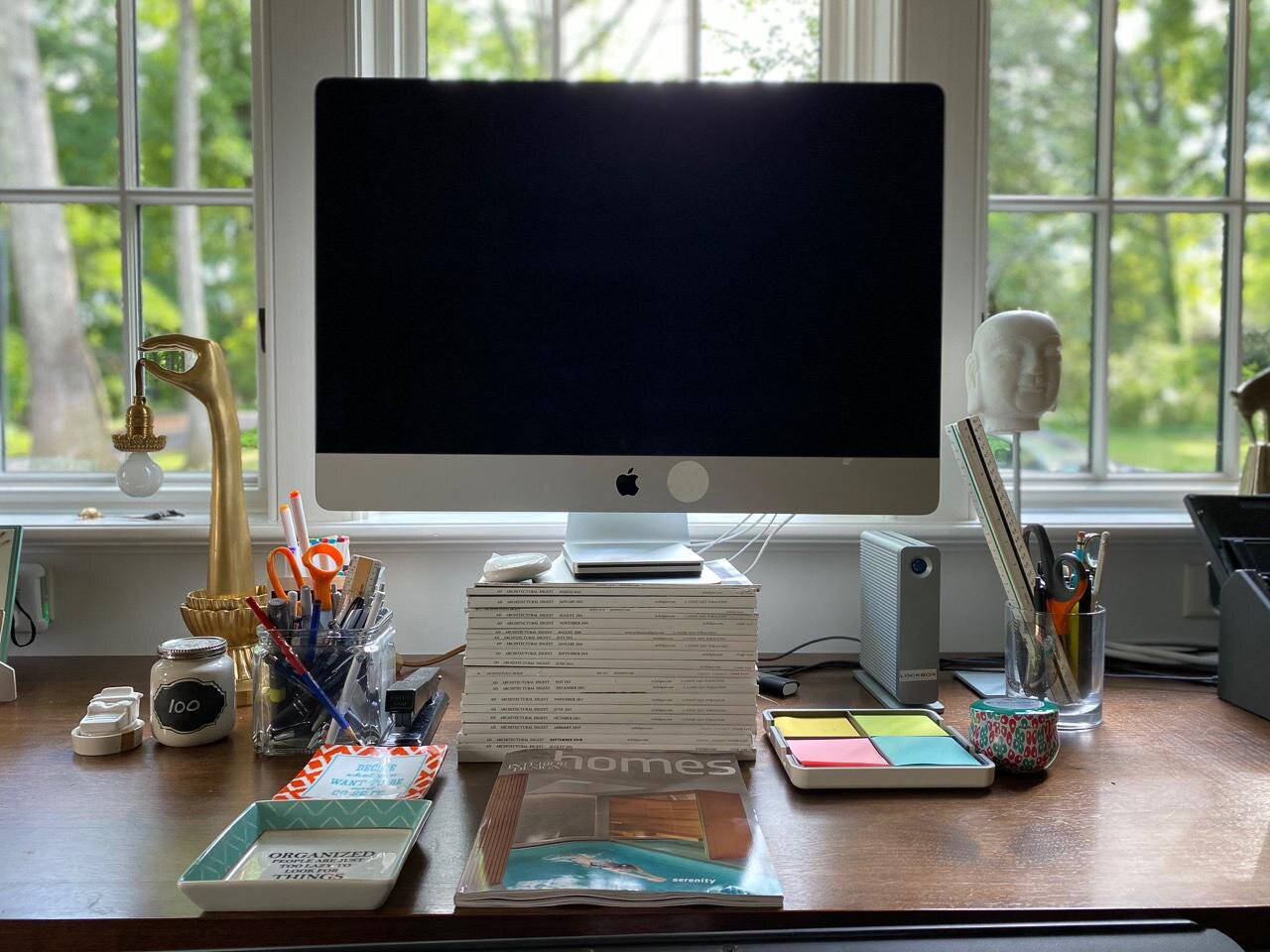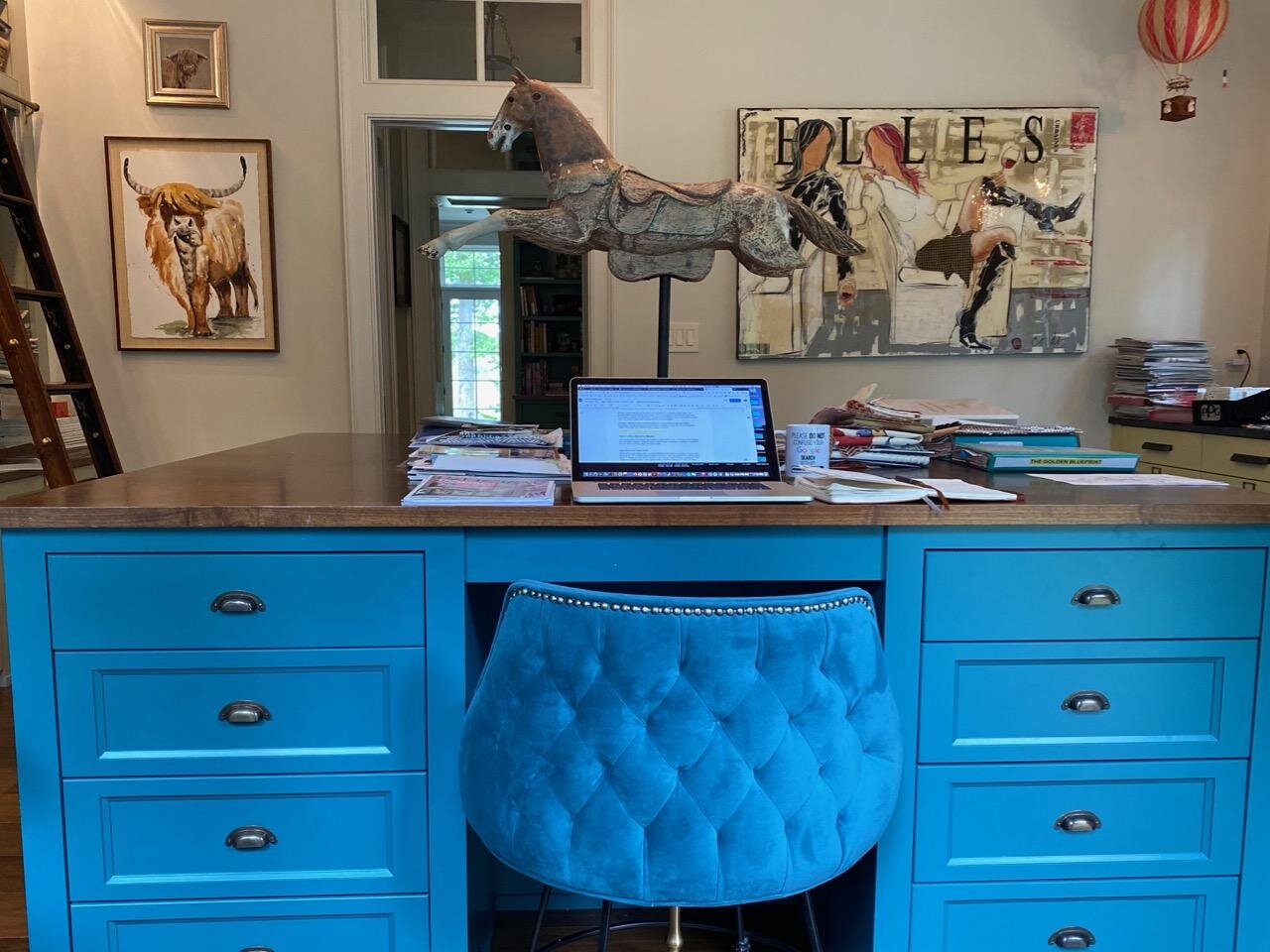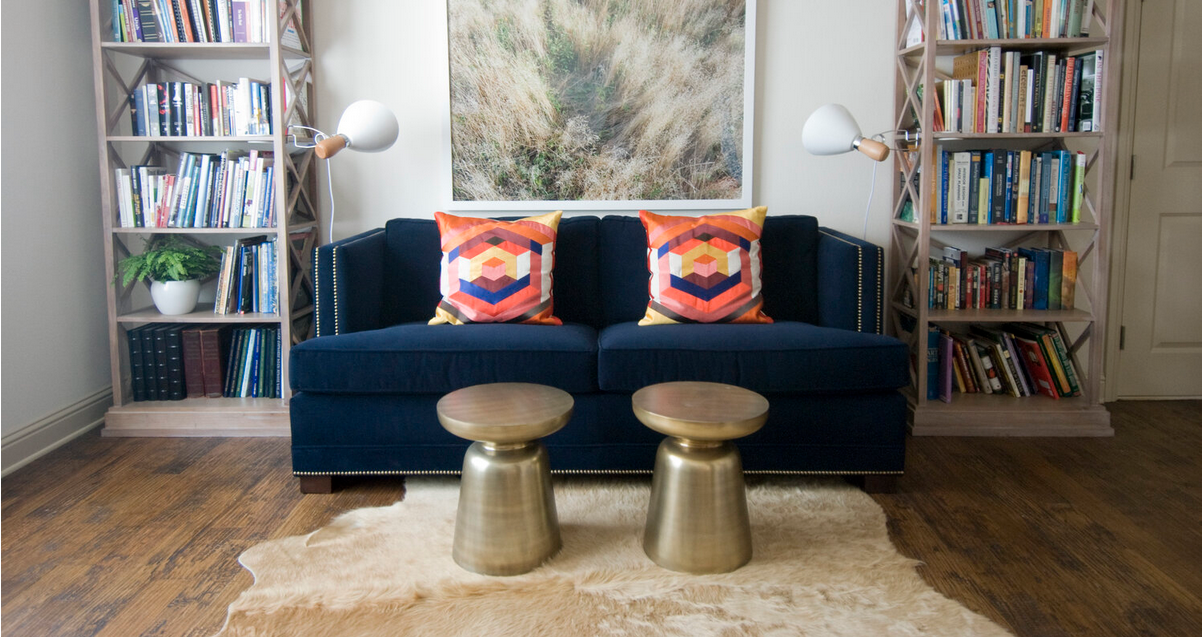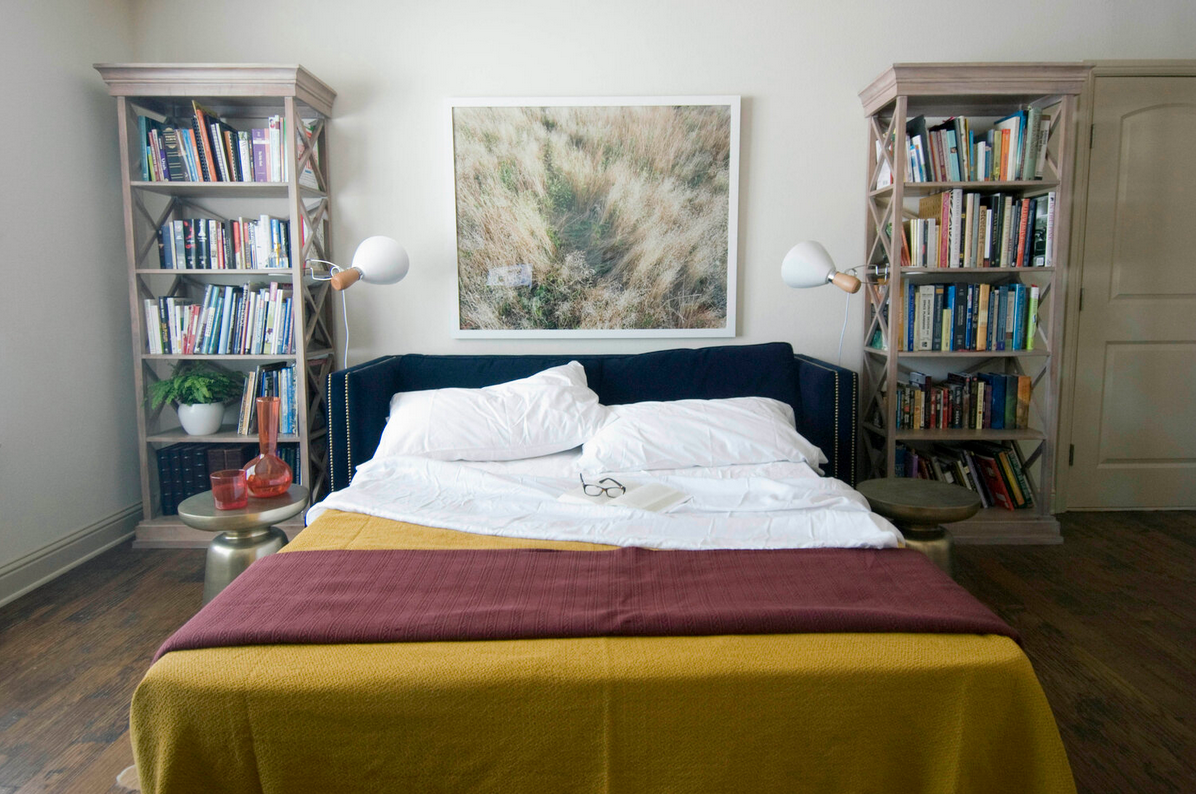Pandemic Pointers: Working From Home (WFH)…The Long Haul
My client’s Mies van der Rohe inspired Barcelona daybed is now a favorite spot for Cooper during long work-at-home days. You can read my blog post here about this MCM home office design.
Perfecting the Home Office: Finishing Touches
A few weeks ago, I posted WFH Part One Perfecting the Home Office, which is a part of this Pandemic Pointers series. In Part One, I brought the home office back to basics and highlighted the top three essential components (desk & chair, lighting, and storage) that make or break the workspace. In this post, I’d like to bring your attention to some extra details that really bring the whole work environment together, and make your space unique and perfect for you!
Evaluate Your Space
The first step to truly perfect your home office is being honest about the space available to you and what you can achieve. Sure, that photo I see from a favorite designer on Instagram is exactly the kind of room I want to create, but I’ve learned the hard way that re-creating isn’t the right way to go about designing!
When designing my own home office in Richmond, I originally decided that I wanted my desk to face the window. Gazing lovingly at my front yard while hard at work on a client project sounded perfect to me! But, actually, I found that I really did not like having my back to the door. I was constantly curious about what was happening behind me -- even though it was just me and Ernie in the house! In the photos below, on the left is my main desk facing the window, and on the right is my secondary desk -- for when my “being watched from the kitchen” paranoia really gets the better of me!
This article on Office Feng Shui describes exactly what happened to me: apparently my personal Chi did flow right out the window! It’s what ultimately led me to have a main desk and a secondary desk in my office. My space allowed for it, and it let me develop two zones for my creative work.
When making plans to create or revamp your home office, be honest with yourself about the space. Every single room has multiple possibilities for how it can be designed and arranged, but it all starts with knowing what will and won’t fit!
Here are a few of the first things I analyze when I begin reimagining a space:
Measure! You should have at least 2’-3’ around each major furniture piece in your home office (desk/chair, lounge chair/loveseat, etc.)
If there is one piece of furniture that a client insists must be in the room, I start with that piece and design the room around it.
Where is the egress? You should be able to walk through your office without zigzagging from point A to point B.
What is the focal point or view? This is what you are going to be looking at the most when you’re in the room. In my case, it turns out I want to see what’s going on in the kitchen!
How is the lighting? Facing a window isn’t necessarily the best light when working on a computer screen. Where are the room’s outlets located, and how can I plan lighting solutions around their placement?
This home office floor plan serves as a great example for how I approach a new room and keep everything I mentioned above in mind. It allows me to visualize the space and, realistically, how many pieces of furniture I can use! Check out my blog post to read the story about this mid-century modern inspired home office design.
Creating Zones
Think of a zone as an area where a particular activity takes place. Creating separate spaces within your home office is important to keep you motivated and energized throughout the day. I know that I can’t be the only one falling victim to my pantry full of snacks these days -- it’s all too easy to “take a break” by walking to the kitchen and snacking. While this isn’t totally terrible, there are more productive ways to take breaks or change up your day. Some zoning to think about:
This corner in a kitchen is sleek, elegant, and simple, but it’s definitely not something that would work for me personally. That wine bottle is a bit too convenient! Blending work and “play” zones in your house is a recipe for endless distraction and less productivity. Source.
Physical Zones
Arranging your desk in your space can create many different areas for your home office set up. Having different zones in your office presents a great opportunity to reset and approach your work with a clear mind. Take a peek at this gorgeous room designed by Catherine Brown Patterson Design:
Photo by Nick Johnson. Source.
First of all, how about that blue theme?! I love how the angled desk creates a cozy space to really focus and be productive. It blocks off the “work zone” while creating a beautiful view for the worker! Plus, the daybed/loveseat on the left could easily be where you bring your laptop to change things up a bit, but it also means this space doubles as a guest room (when we’re allowed to have guests again!).
Monika Merchant Design Studio in Fort Worth, Texas did the same thing in the room pictured below. Who would’ve suspected that there was a bed in this beautiful sofa? And look at those bookcases; what a great opportunity for work-related storage (see WFH Part One)!
I love the blue sofa on its own, but my favorite aspect of this set up is the hidden bed stored within, and how those two side tables easily convert to bedside tables. Bed-making tips, anyone??
Mixed Zones
Sometimes it’s not possible to have an entire space dedicated to one purpose. When we are at our beach house, I don’t have a dedicated office space so I convert the dining room into my work zone during the day. The bookcase cabinets are perfect for storing all of my office tools at the end of the day, transforming this room back into a dining room and keeping all of that clutter out of sight. I love creating built-in cabinets in homes -- a large part of cabinetry design is the ability to create a unit that serves multiple purposes, in addition to looking beautiful.
This living room-meets-office/library takes bookcases to a whole new level. That desk could also be used as a dining table, which makes this a great space that does triple-duty(living room/office/dining). Source: @kellybehunstudio and @williamwaldronphoto.
Creating zones within one room is one of my favorite puzzles to play with. As I mentioned, each room presents multiple possibilities! However, you arrange your space, make sure it’s adequately lit -- see WFH Part One! Think table lamps, sconces, and floor lamps as additional lighting opportunities to your ceiling fixtures and recessed lights.
Non-Physical Zones
Once you’ve “blocked off” your work zone then Rule #1, according to tech company Skillcrush, is to establish some mental boundaries. Otherwise, your work-life risks taking over your home. You can have the most beautifully designed room or workspace, but without implementing a few of these tips, you won’t be able to find true balance in your home over the course of this pandemic.
This mom has it going on!
There are common threads among the many articles now circulating about WFH and maintaining boundaries, including the Skillcrush article I linked to above. Whether you’re working from a spacious home office, or your bedroom (have you made the bed?!), these themes should be applied in how you approach your workday in order to stay focused on work.
I covered the most recurring theme, which is creating a dedicated workspace, whether it’s an entire room or a specific zone in a larger space. Don’t forget the three main building blocks of any home office, detailed in WFH Part One!
Here are some other helpful hints I’ve found and think are really useful:
If you haven’t already, consider setting your new working hours. We don’t have commutes anymore, so it’s more than tempting to jump straight into work early in the morning. If that works for you, that’s great. But for many of us, it just makes our days even longer. Maybe use that commute time to work out, journal, or catch up on laundry!
Commit to signing on at a certain time, schedule your lunch break, and be sure to hold yourself accountable for logging off at around the same time each night.
Get dressed! I admit, the first few days at home included a lot of lounging around in pajamas or sweatpants all day. Now that we’re facing a bit more permanence with this work environment, it’s important to at least change out of your PJs for the day! Take the time to “get ready,” even if your routine has shifted a bit. I’ll turn once again to FlyLady and her great article on the importance of getting dressed “to shoes.” Her reasoning is “that you act differently when you have clothes and shoes on. You are more professional”. I have found, psychologically, that to be the case.
Establish some daily rituals. These might have already formed organically. However, there is nothing wrong with making a conscious effort to make them stick. This could be having your morning coffee in the same mug every day, using the same water bottle every day (and perhaps monitoring it to make sure you’re drinking enough water), timed breaks, or whatever fits best into your work routine.
One of the best books I’ve read this year is Atomic Habits: An Easy & Proven Way to Build Good Habits and Break Bad Ones by James Clear. This book tackles the big questions that come up when we consider the importance of rituals in our lives (not just our work life). This is an essential read for everyone, whether you’re working from the bedroom or the office!
A Few of my Favorite Things
I’ve highlighted some of the practical solutions to perfecting the home office, but something that is often overlooked in home office design is how to make the space truly yours and promote your own well-being. Adding an indoor plant or two, investing in an essential oil diffuser, and playing music all can help you focus, de-stress, and feel comfortable in your home office.
I’ve written these two WFH posts to help you begin thinking about how you can perfect your own home office. I have to admit, though, that my office in my Richmond, Virginia home has been where I’m drawing a lot of my inspiration and guidance. You’ve already heard a bit about my office, but I’ve summed up some of my favorite details that help me stay grounded, focused, and as calm as possible in the swirl of stress that is always threatening!
Atmosphere
Part of my daily routine is to start up my diffuser every afternoon when I need a boost of focus and productivity.
This article from the American College of Healthcare Sciences breaks down several other scents and why they are perfect for working from home.
My go-to shop for anything essential oils is Anoush -- it’s local to me in Richmond, VA!
My favorites to use are Lemon and Frankincense essential oils.
Plants
Indoor plants can do so many fantastic things for your mental and physical health. Not to mention they add some green and liveliness to any room.
This article details a few plants that really do wonders for decreasing stress, increasing focus, boosting your overall morale, and literally clearing the air!
Personally, I love my orchids (if you haven’t already, check out my blog post on this amazing, local RVA “Orchid Camp”!) and my succulents. Both are extremely low-maintenance.
Sounds
Unless I’m on a call or am running around and not staying in my office for too long, I always have music playing.
My go-to is the War on Drugs station on Pandora. What kind of music are you partial to when you’re working?
Tools
I find that even if I know I’m having great ideas and am in the zone, I’ll never be fully satisfied with my workflow if I don’t have the right tools.
My life would be chaos if it weren’t for Evernote. There is something to be said about taking notes in my office, and then being able to access those same exact notes on my phone when I’m out buying furniture or fabric for a client.
However, when I’m doing the initial, creative design work, I’m glued to my bullet journal. I love being able to organize it however I want.
My typical daily set up.
The bonus of having my bullet journal is being able to splurge on awesome pens of many different colors-this is about as artistic as I get.
My go-to pen is, of course, my favorite Catherine Jordan Design pens!
Desk
Some desk accessories that I love:
A glass mat from Vitrazza to go under your chair. Whoever thought of this was a pure genius!
A wrist guard mouse pad -- it has definitely saved my wrist during those long days in front of the monitor drawing floor plans. This is the set I use.
Storage
The bookcases in my office are certainly not just for filling with books! I love using bookcases for things that make me happy, like photos, mementos, and pieces of art that I’ve picked up on our travels.
Ready to Get Started?
Now that you have the tools to revamp your working space, I hope your gears are churning about how to create something that helps boost your productivity, creativity, and maintains a balance between work life and home life while we are all housebound! If you’re ready to chat about how to make the spaces in your home more functional (and beautiful!), reach out and say hi, I’d love to hear from you.
Subscribe to my blog to get all future posts straight to your inbox!


















